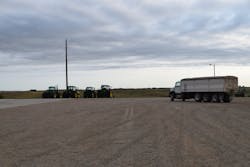Minot, North Dakota, is one of three larger communities that make up the group of North Dakota cities classified as part of the Bakken Formation, and the Three Forks formation.
These geological shale rock formations extend through North Dakota, South Dakota and Montana in the U.S., as well as Manitoba and Saskatchewan in Canada, and house an estimated 7.4 billion barrels of oil and 6.7 trillion cubic feet of natural gas, according to the U.S. Geological Survey.
To extract the oil and natural gas currently, technologies such has horizontal drilling and hydraulic fracturing, or fracking, are employed.
Between 2000 and 2015, Minot, like other North Dakota cities, including Williston and Stanley, saw a large increase in residents to fill the jobs needed to build oil wells, complete the fracking process for those wells, and provide necessary goods and services for the rising population.
The city grew substantially in a small amount of time, leaving many new residents scrambling to find affordable housing in the area. The price to rent was so high, according to local Cornwell Tools dealer Tim Bader, that oil companies would offer an additional stipend just to pay for room and board. Alternatives also included living in one of the many nearby “man camps,” which were portable housing units built along stretches of highway closer to drilling operations.
“You need a price of about $60 (per barrel) minimum (to make a profit),” Bader says. “We had $200 barrel of oil a couple years ago. They were making money like crazy then. It was a free-for-all. If you could breathe, you could get a job.”
Due to the recent stagnation of oil prices, fracking has no longer been as lucrative as it once was.
“Minot is on the fringe with the oil boom,” explains Bader. “There isn’t an oil well located within 60 miles of here, but there are a lot of companies based out of here. The towns of Williston and Stanley, some of these other communities were so small, they didn’t have near the infrastructure to take care of all this equipment. If you went west toward Williston, there were all kinds of “man camps” on the highway.”
It’s widely accepted that the boom began to bust (or at least pause until further notice) in March 2015. As of August 2016, U.S. WTI crude oil prices still remain at about $45 per barrel. This has translated to a decline in population and halted construction projects in the area.
“For what’s left of the transplants, about 15 percent of the population is left,” he says. “At one time probably close to 40 (percent).
Bader says the population before the boom was about 40,000; and at its peak there were about 60,000 residents including transients, in the surrounding area.
“There are still a lot of good jobs for people out there, on the service side of the industry,” Bader says. “These wells have to be maintained. What creates the most activity is the drilling and fracking. You have to haul so much water out there to frack the well.”
In the meantime, the local economy sustains on the agricultural and ranching industries in the area, as well as the U.S. Air Force base 15 miles north of the city.
“Everybody’s expecting an uptick in the business again,” Bader says. “Nobody seems to know when. But [the price of] oil has to go up.”


